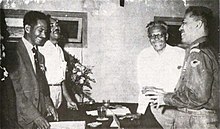Silas Papare
Silas Ayari Donrai Papare (18 December 1918 – 7 March 1978) was a Papuan–Indonesian politician and guerilla leader who is a National Hero of Indonesia.
Originating from the Yapen Islands, Papare trained and worked as a nurse prior to the Second World War, during which he organized local resistance and gathered intelligence against occupying Japanese forces.
Open fighting against the Japanese forces started on 10 October 1942, on Manswan Beach South Biak, which resulted in about 2000 local casualties.
Based on Papare reports, allied forces were able to sink Daito Maru, Japanese supply ship heading to Serui.
Papare headed back to Nau from Serui in torpedo boat to scout Japanese position in Warenai and Sorong and supervised the construction of local defense in 13 days.
A 20-man Dutch-Australian-American rescue team led by Dutch 2nd lieutenant Louis Rapmund (who was an officer with NICA) was dropped off by a Catalina flying boat at the mouth of the Kais River and went upstream to find the crashed bomber in the swamps.
[15] At that time, his anti-Indonesian views were known, stemming from his observations of Indonesian civil servants in Papua being submissive to Japanese authorities while being repressive against Papuans.
[3][7] Although he would also made contacts pro-Indonesian figures such as Marthen Indey from Papuan Battalion, as well as Corinus Krey, who was adjudant to Atmoprasojo, from his hospital work in Harapan village.
He would be involved in the formation of student organization tasked of helping Sugoro Atmoprasojo, with other members including Lukas Rumkorem, Yan Waranu, G. Sawari, S.D.
KNIL forces from Kloofkamp, Hollandia who were predominantly Christian Ambonese and Minahasan would mobilized and attack Harapan Village located 40 km away.
Due to these events, Dutch authorities decided to send Frans Kaisiepo instead of Papare to the Malino Conference to represent Papua in the formation of the State of East Indonesia, to not alienate the Ambonese whose support were crucial for the formation of the pro-Dutch “State of East Indonesia,” a decision which slighted Papare.
[3][7] On 17 July 1946, coinciding with Malino Conference, Panggoncang Alam (from Minangkabau) would lead a failed rebellion to free Atmoprasojo and other captured figures by disarming KNIL troops and attacking vital installations, because of Papare and Indey possible involvement, they were exiled to Serui.
[22] Papare attained a sort of a messianic reputation locally, regarding being a savior from Dutch colonialism into an imagined utopia under Indonesian rule.
[7] Although on 16 March 1949, PKII released a motion that it still exist to support integration with Indonesia and asked to be involved in negotiation of Indonesia-Netherlands-UN (KTN).
[27] Between 1951 and 1954, Papare worked in hospitals in Jakarta, before he was appointed to the Provisional People's Representative Council on 24 March 1954 to replace the deceased Rajiman Wediodiningrat.
In 1953, Indonesian government formed Irian Bureau, where Papare became the first Commissioner, to fight for Indonesia integration and serve as embryo for governorship.
[14][31][32] Canadian researcher David Webster claimed that in 1961 Papare told the American Ambassador to Indonesia at the time that he intended to return to Papua to support the growing independence movement, and that he was threatened with arrest for his criticism of Sukarno, despite Papare being considered as the future Indonesian governor of Papua at that time.


